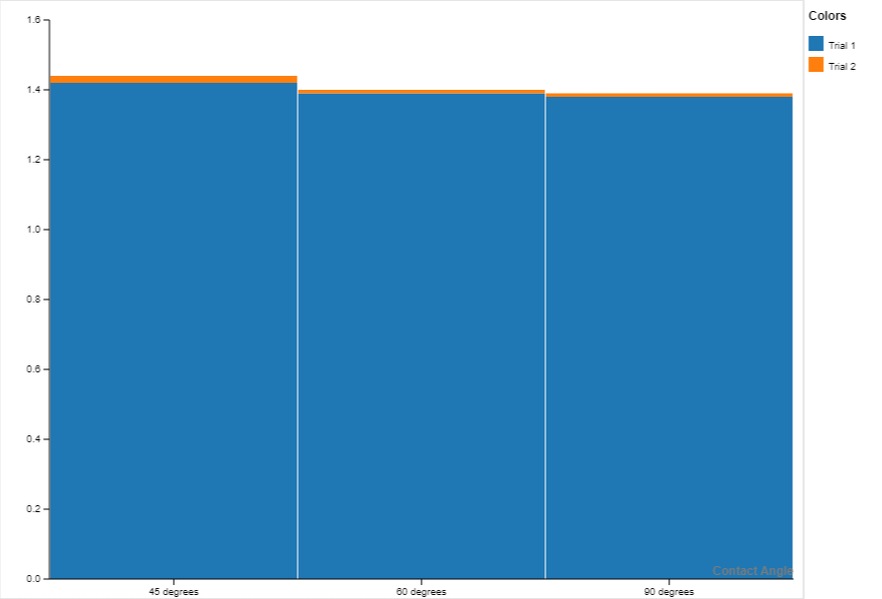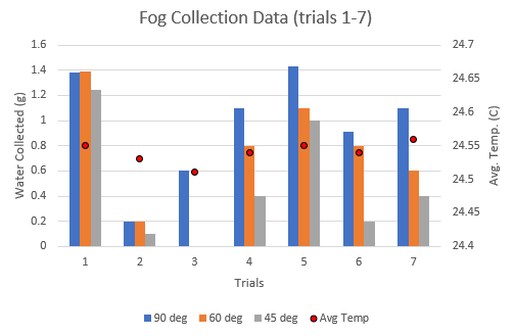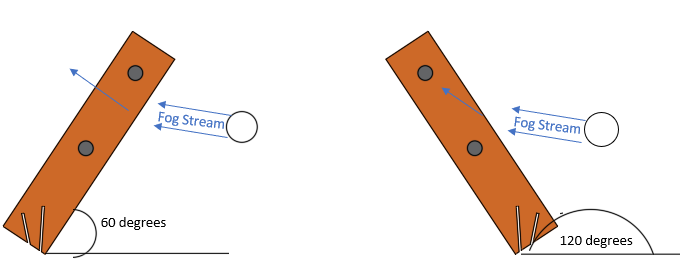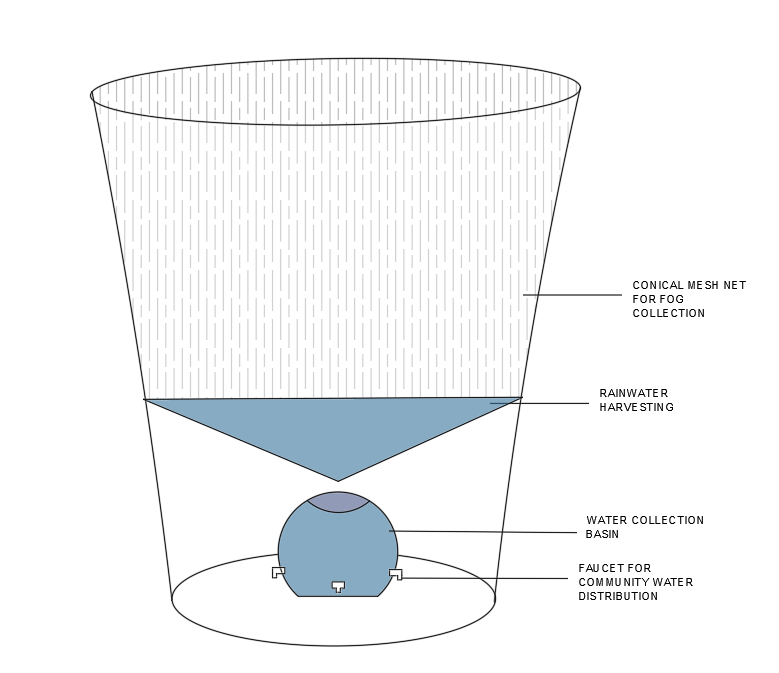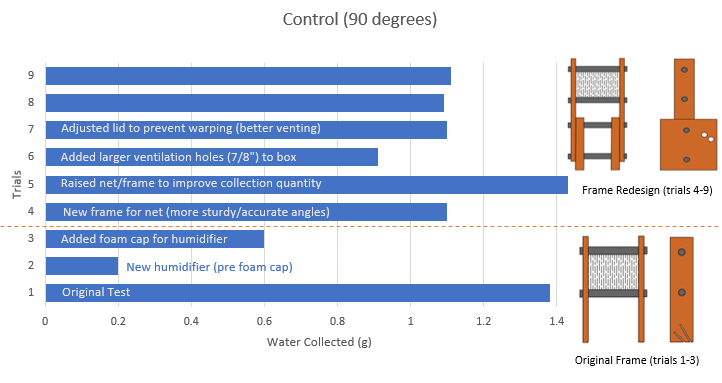 Figure 2. Evolution of fog collection frame design compared with previous results
Figure 2. Evolution of fog collection frame design compared with previous results
Figure 2 shows the evolution of the fog collection design as different aspects of the box and wire frame were altered in attempts to increase collection efficiency. The orange dotted line represents the switch from the original frame design (trials 1-3) to the improved design (trials 4-9). Despite the constant alterations preventing direct comparisons between the majority of the trials, this data may provide some insight into the importance of installing these devices in the proper location. The highest recorded yields were seen in Trial 1 which utilized a humidifier with a higher flow for the fog stream, and Trial 5 which raised the vertical mesh/frame to improve collection efficiency. These results could suggest that the placement and/or location of these devices has a significant impact on collection efficiency, specifically collection yield increases when the device is placed slightly above the strongest/densest fog stream in the given area.
Trials 1-3
The replacement of the humidifier (used to produce the fog stream) introduced variability within the results. After including a well-fitting foam cap on the new humidifier did not produce a sample close to the original trial, despite other aspects of the experiment remaining constant, it was assumed that the flow resulting from the replacement humidifier was significantly weaker than its predecessor.
Trials 4-9
After addressing design issues associated with the new humidifier (used to produce the fog stream), it became apparent that alterations to the frame were needed to increase collection efficiency. The frame redesign replaced the angled slits on the base for a more secure and accurate dowel-based system. Each new trial allowed for improvements to the control condition, such as raising the frame to capture more of the fog stream and adding better ventilation to prevent excessive pressure and condensation buildup within the environmental chamber.
The replacement of the humidifier (used to produce the fog stream) introduced variability within the results. After including a well-fitting foam cap on the new humidifier did not produce a sample close to the original trial, despite other aspects of the experiment remaining constant, it was assumed that the flow resulting from the replacement humidifier was significantly weaker than its predecessor.
Trials 4-9
After addressing design issues associated with the new humidifier (used to produce the fog stream), it became apparent that alterations to the frame were needed to increase collection efficiency. The frame redesign replaced the angled slits on the base for a more secure and accurate dowel-based system. Each new trial allowed for improvements to the control condition, such as raising the frame to capture more of the fog stream and adding better ventilation to prevent excessive pressure and condensation buildup within the environmental chamber.
Results
|
Figure 3 depicts the collection of results for all tested angles in Trials 1-7. This figure is perhaps the best representation of how user error impacted the efficacy of this experiment. Due to a misinterpretation of the design instructions, tests were conducted for all three angles in each trial despite not having the control conditions set. This resulted in a significant waste of time and effort attempting to gather data for each angle during all trials. It is now clear that Trials 1 - 7 should have only included data from the control condition (90 degrees); obtaining data from the other angles was unnecessary until all changes to the frame and environmental chamber were complete.
|
Although initially disheartening, the data depicted in Figure 3 was somewhat useful. The data collected from these trials clearly show that regardless of the changes made to the frame or environmental chamber, the 90 degree contact angle had the best interception efficiency, followed by the 60 degree and 45 degree angles. This did not match my initial hypothesis which proposed 60 degrees as the angle producing the highest yield.
It was assumed that the 60 degree angle would have a higher interception efficiency due to the ability of the net to collect additional moisture as the fog moved though it. Since the fog travels upwards in a diagonal direction, tilting the net at different angles was meant to provide additional surface area for the fog to collect on. However, this would have been more effectively achieved with a contact angle larger than 90 degrees, such as the 120-degree angle depicted in Figure 4. Simply put, having the frame tilt away from the fog stream instead of toward it would have produced a higher yield.
It was assumed that the 60 degree angle would have a higher interception efficiency due to the ability of the net to collect additional moisture as the fog moved though it. Since the fog travels upwards in a diagonal direction, tilting the net at different angles was meant to provide additional surface area for the fog to collect on. However, this would have been more effectively achieved with a contact angle larger than 90 degrees, such as the 120-degree angle depicted in Figure 4. Simply put, having the frame tilt away from the fog stream instead of toward it would have produced a higher yield.
Figure 4. Example diagram of fog collection for 60 degrees vs 120 degrees
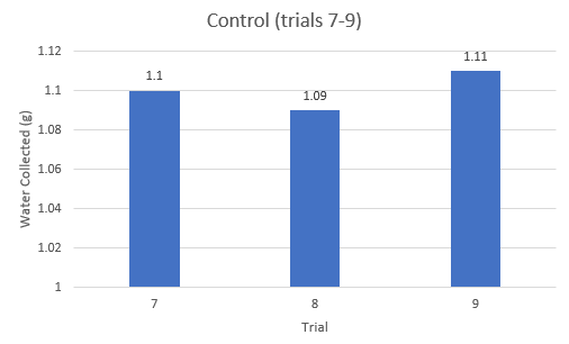 Figure 5. Fog collection results (Trials 7-9)
Figure 5. Fog collection results (Trials 7-9)
Figure 5 depicts the results of trials 7-9 which all have the same design conditions for both the frame and environmental chamber. These three trials are the most eligible for comparison and show that this experiment was eventually able to produce consistent results.
Future Directions
Future directions for this research may include tests conducted on contact angles greater than 90 degrees in addition to testing the collection efficiency of other mesh materials such as polyurethane, polypropylene, or nylon. These materials have been successfully used in other fog collection studies and may be more accessible than stainless steel for some regions. Because fog collectors require a lot of surface area to produce significant results, future improvements may also include installing additional layers to the mesh net to make the device both compact and effective. In the absence of time constraints, I would have liked to use the data from these additional tests to explore alternative orientations that utilized multiple angles across the net’s surface area (varying degrees of a concave shape for the net). Additionally, extra layers could be added behind existing net layers to create a collective mesh that becomes taller with each new layer added. The realization that fog travels most directly on an increasing diagonal path led to a new hypothesis that the additional height/layers may catch additional condensation, while a concave shape could allow the net to maintain enough adhesion force to form large droplets.
Access:
This fog collector is easy for anyone to construct and test. A support frame can be made from a variety of natural materials local to the region such as bamboo, or timber branches while the mesh net can be made with generic stainless-steel wire. Polypropylene, polyurethane, and nylon have been successfully used in other fog collection studies and could supplement the stainless-steel wire when access to the metal is limited or financially prohibitive. Because this device uses passive collection techniques it can be tested and implemented without dependence on alternative energy sources, making testing a modified version of this device possible for virtually any community.
The testing device is easily replicated and made from common materials, however if access to polycarbonate or acrylic for constructing the environmental chamber is limited, simple insulation foam could be supplemented assuming it can be dried completely between tests. Although the experiment for this project included an environmental chamber it is not necessarily a requirement. Modified versions of this test have been conducted successfully without the use of an environmental chamber. Instead, the testing device might be more useful for pinpointing the ideal location of the mesh net relative to the direction of an area's fog currents. Because convection currents are responsible for producing fog streams, local meteorological data can be used to track their patterns and identify the ideal location for the fog collector. These results could then be confirmed through use of a small testing device consisting of a collection net on a height-adjustable frame; this test device would not necessarily need to be large.
Innovative Design:
The river basins providing most of the water for SEA communities are proportionally very small compared to the populations they support; this imbalance results in a speedy depletion of groundwater resources. As tropical climates, many of these regions will also experience excess flooding and monsoon rains during the wet season, followed by drought in their dry season. Due to the unevenly distributed precipitation observed throughout the year across SEA, a large-scale fog collection system could provide rural communities with an additional freshwater source that remains reliable regardless of the season. Obtaining fresh water through this type of passive design could reduce the strain on vulnerable water reserves and help to prevent the over extraction of groundwater year-round while also providing an additional water source during the droughts of the dry season.
Access to fresh water is expected to become increasingly limited with each passing year. To prevent additional scarcity instigated by emission-induced warming and over extraction of groundwater supplies, non-invasive and passive methods for obtaining fresh water must be discovered and utilized. The majority of fog collection devices are most effective when implemented on a large scale for the purpose of serving an entire community’s non-potable water needs, especially in rural areas. Promising innovations for this concept may consist of a conical/cylindrical mesh net that encompasses a large area, as seen in Figure 6. Because the net spans an entire 360 degrees around a circular frame, fog could be collected from all angles regardless of wind direction. Additionally, a circular cross section would automatically include dual mesh layers that could easily be added to depending on the needs of the community.
The customizable nature of the design gives communities additional agency in distributing their resources. For example, collectors utilizing a higher density mesh have also been used to provide adequate shade to crops (and people) in addition to its fog collecting functions. The device could even go one step further by doubling as a rainwater harvesting device. Considering a standard fog collector already contains a reservoir for collecting condensed fog, an additional catchment could easily be added within the frame for the added function of collecting rainwater. In a large-scale design installed to accommodate an entire community, the collection basin for fog and rainwater could also include faucets to distribute water any time. Inclusive access to this type of utility would likely turn the device’s surrounding area into a common gathering hub for the community. This type of social cohesion could be further encouraged through the installation of features such as higher density mesh to produce shade, or water features that promote evaporative cooling.
Access:
This fog collector is easy for anyone to construct and test. A support frame can be made from a variety of natural materials local to the region such as bamboo, or timber branches while the mesh net can be made with generic stainless-steel wire. Polypropylene, polyurethane, and nylon have been successfully used in other fog collection studies and could supplement the stainless-steel wire when access to the metal is limited or financially prohibitive. Because this device uses passive collection techniques it can be tested and implemented without dependence on alternative energy sources, making testing a modified version of this device possible for virtually any community.
The testing device is easily replicated and made from common materials, however if access to polycarbonate or acrylic for constructing the environmental chamber is limited, simple insulation foam could be supplemented assuming it can be dried completely between tests. Although the experiment for this project included an environmental chamber it is not necessarily a requirement. Modified versions of this test have been conducted successfully without the use of an environmental chamber. Instead, the testing device might be more useful for pinpointing the ideal location of the mesh net relative to the direction of an area's fog currents. Because convection currents are responsible for producing fog streams, local meteorological data can be used to track their patterns and identify the ideal location for the fog collector. These results could then be confirmed through use of a small testing device consisting of a collection net on a height-adjustable frame; this test device would not necessarily need to be large.
Innovative Design:
The river basins providing most of the water for SEA communities are proportionally very small compared to the populations they support; this imbalance results in a speedy depletion of groundwater resources. As tropical climates, many of these regions will also experience excess flooding and monsoon rains during the wet season, followed by drought in their dry season. Due to the unevenly distributed precipitation observed throughout the year across SEA, a large-scale fog collection system could provide rural communities with an additional freshwater source that remains reliable regardless of the season. Obtaining fresh water through this type of passive design could reduce the strain on vulnerable water reserves and help to prevent the over extraction of groundwater year-round while also providing an additional water source during the droughts of the dry season.
Access to fresh water is expected to become increasingly limited with each passing year. To prevent additional scarcity instigated by emission-induced warming and over extraction of groundwater supplies, non-invasive and passive methods for obtaining fresh water must be discovered and utilized. The majority of fog collection devices are most effective when implemented on a large scale for the purpose of serving an entire community’s non-potable water needs, especially in rural areas. Promising innovations for this concept may consist of a conical/cylindrical mesh net that encompasses a large area, as seen in Figure 6. Because the net spans an entire 360 degrees around a circular frame, fog could be collected from all angles regardless of wind direction. Additionally, a circular cross section would automatically include dual mesh layers that could easily be added to depending on the needs of the community.
The customizable nature of the design gives communities additional agency in distributing their resources. For example, collectors utilizing a higher density mesh have also been used to provide adequate shade to crops (and people) in addition to its fog collecting functions. The device could even go one step further by doubling as a rainwater harvesting device. Considering a standard fog collector already contains a reservoir for collecting condensed fog, an additional catchment could easily be added within the frame for the added function of collecting rainwater. In a large-scale design installed to accommodate an entire community, the collection basin for fog and rainwater could also include faucets to distribute water any time. Inclusive access to this type of utility would likely turn the device’s surrounding area into a common gathering hub for the community. This type of social cohesion could be further encouraged through the installation of features such as higher density mesh to produce shade, or water features that promote evaporative cooling.
